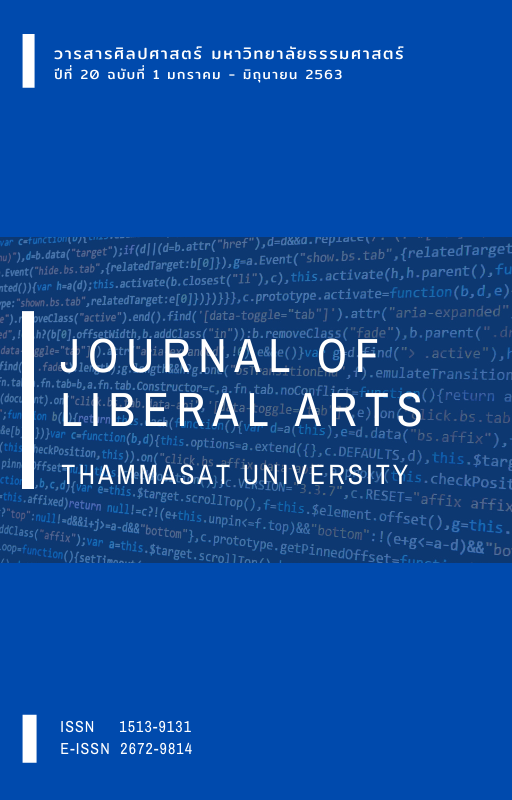ความแตกต่างระหว่างเพศกับการรับรู้คุณภาพเสื้อผ้าจากรูปแบบการนำเสนอเสื้อผ้าออนไลน์
Main Article Content
บทคัดย่อ
งานวิจัยชิ้นนี้มีวัตถุประสงค์เพื่อศึกษาอิทธิพลของเพศและตัวแบบใน การนำเสนอเสื้อผ้าบนเว็บไซต์ต่อการรับรู้คุณภาพเสื้อผ้า โดยเลือกสุ่ม กลุ่มตัวอย่างจำนวน 100 คน จากนักศึกษามหาวิทยาลัยธรรมศาสตร์ กลุ่มตัวอย่างทุกคนได้รับชมภาพจำลองการนำเสนอเสื้อผ้าบนเว็บไซต์ ซึ่งแบ่งเป็น 3 รูปแบบ ได้แก่ การนำเสนอเสื้อผ้าพร้อมใบหน้าของตัวแบบ การนำเสนอเสื้อผ้าโดยไม่ปรากฏใบหน้าของตัวแบบ และการนำเสนอเสื้อผ้าโดยไม่มีตัวแบบ จากนั้นให้ทำการประเมินคุณภาพเสื้อผ้าตามการรับรู้ ผลจากการวิเคราะห์ด้วยสถิติ Mixed-model Anova พบว่าเพศไม่มีอิทธิพลหลักต่อการรับรู้คุณภาพเสื้อผ้าออนไลน์ แต่ประเภทของเสื้อผ้าจำแนกตามเพศ และรูปแบบการนำเสนอมีอิทธิพลหลักต่อการรับรู้คุณภาพเสื้อผ้าอย่างมีนัยสำคัญทางสถิติ นอกจากนี้ ยังพบอีกว่ามีปฏิสัมพันธ์ระหว่างประเภทเสื้อผ้าจำแนกตามเพศกับรูปแบบการนำเสนอเสื้อผ้า และปฏิสัมพันธ์ระหว่างประเภทเสื้อผ้าจำแนกตามเพศกับเพศอย่างมีนัยสำคัญทางสถิติ
Downloads
Article Details
เอกสารอ้างอิง
กรมพัฒนาธุรกิจการค้า. (กันยายน 2559). ธุรกิจขายปลีกทางอินเทอร์เน็ต. สืบค้นเมื่อวันที่ 15 พฤษภาคม 2561 จาก http://www.dbd.go.th/dbdweb56/ewt_dl_link.php?nid=469402219
เจษฎาภรณ์ ศรศรีเกิด. (2555). ปัจจัยที่มีอิทธิพลต่อการตัดสินใจเลือกซื้อสินค้าผ่านโซเชียลมีเดียของนักศึกษามหาวิทยาลัยเชียงใหม่ (การศึกษาค้นคว้าอิสระปริญญามหาบัณฑิต). มหาวิทยาลัยเชียงใหม่, เชียงใหม่.
ติมาพร อัมนักมณี. (2558). ผลของการใช้รูปคนในการนำเสนอสินค้าบนเว็บไซต์พาณิชญ์อิเล็กทรอนิกส์ที่มีต่อความไว้วางใจ การตรึงสายตา และความตั้งใจซื้อ (วิทยานิพนธ์ปริญญามหาบัณฑิต). จุฬาลงกรณ์มหาวิทยาลัย, กรุงเทพฯ.
ธัญญพัสส์ เกตุประดิษฐ์, และอิทธิกร ขำเดช. (2554). ปัจจัยที่มีอิทธิพลต่อการตัดสินใจซื้อสินค้าทางอินเตอร์เนตของผู้หญิงในเขตกรุงเทพมหานคร. วารสารการเงิน การลงทุน การตลาด และการบริหารธุรกิจ, 1(2), 21-39.
นพมาศ อุ้งพระ. (2555). จิตวิทยาสังคม. กรุงเทพฯ: สำนักพิมพ์มหาวิทยาลัยธรรมศาสตร์.
ปุญญนุช บุณยะสุนานนท์. (2557). ปัจจัยที่มีผลต่อการซื้อเสื้อผ้าสตรีผ่านช่องทางออนไลน์ ของผู้หญิงวัยทำงาน (การศึกษาค้นคว้าอิสระปริญญามหาบัณฑิต). มหาวิทยาลัยธรรมศาสตร์, กรุงเทพฯ.
ลักษณารีย์ ยิ่งเกรียงไกร. (2557). ปัจจัยที่ส่งผลต่อความตั้งใจซื้อสินค้าแฟชั่นผ่านทางอินเทอร์เน็ตของผู้บริโภคในเขตกรุงเทพมหานคร. วารสารวไลยอลงกรณ์ปริทัศน์, 4(1), 1-12.
วรัญญา โพธิ์ไพรทอง. (2556). ปัจจัยที่ส่งผลต่อการตัดสินใจซื้อเสื้อผ้าจากร้านค้าออนไลน์ (การศึกษาค้นคว้าอิสระปริญญามหาบัณฑิต). มหาวิทยาลัยธรรมศาสตร์, กรุงเทพฯ.
สำนักพัฒนาธุรกรรมทางอิเล็กทรอนิกส์. (29 กันยายน 2560ก). มูลค่าอีคอมเมิร์ซไทยปี 59 และคาดการณ์มูลค่าปี 60. ค้นเมื่อวันที่ 15 พฤษภาคม 2561, สืบค้นจาก https://www.etda.or.th/content/value-of-e-commerce-survey-in-thailand-2017.html
สำนักพัฒนาธุรกรรมทางอิเล็กทรอนิกส์. (27 กันยายน 2560ข). ETDA เผยผลสำรวจพฤติกรรมใช้อินเตอร์เน็ตและมูลค่าอีคอมเมิร์ซ โชว์ความพร้อมไทยก้าวขึ้นเป็นเจ้า อีคอมเมิร์ซอาเซียน. ค้นเมื่อวันที่ 15 พฤษภาคม 2561, สืบค้นจาก https://www.etda.or.th/content/ thailand-internet-user-profile-2017-and-value-of-e-commerce-survey-in-thailand-2017l-press-conference.html
Ahmed, R., Seedani, S., Ahuja, M., & Paryani, S. (2015). Impact of Celebrity Endorsement on Consumer Buying Behavior. Retrieved from https://ssrn.com/abstract=2666148 on May, 15th 2018.
Bakewell, C., & Mitchell, V-W. (2006). Male versus female consumer decision making styles. Journal of Business Research, 59, 1297-1300.
Castelo, J. S. R., & de Oliveira Cabral, J. E. (2018). Consumers in social network: the perception of clothing quality per gender. Review of Business Management, 20(1), 22-36.
de Klerk, H. M., Jacobs, B., & van Heerden, C. H. (2014). Online evaluation of apparel products as part of female consumers’ decision making processes. Paper presented at Marketing, Technology and Customer Commitment in the New Economy. 119-123.
de Klerk, H. M., & Lubbe, S. (2006). Female consumers’ evaluation of apparel quality: Exploring the importance of aesthetics. Journal of Fashion Marketing and Management: An International Journal, 12(1), 36-50.
Dholokia, R. R. (1999). Going shopping: key determinants of shopping behaviours and motivations. International Journal of Retailing and Distribution Management, 27(4), 154-165.
Fiore, A. M., & Damhorst, M. L. (1992). Intrinsic cues as predictors of perceived quality of apparel. Journal of Consumer Satisfaction, Dissatisfaction and Complaining Behavior, 5, 168-178.
Fiore, A. M., & Kimmel, P. A. (1997). Understanding aesthetics: For the merchandising and design professional. NY: Fairchild.
Ghani, U., Kakakhel, T. (2011). The impact of celebrity endorsement on the youth of Pakistan. International Proceedings of Economics Development and Research, Singapore.
Gitimu, P. N., Workman, J., & Robinson, J. R. (2013). Garment quality evaluation: Influence of fashion leadership, fashion involvement, and gender. International Journal of Fashion Design, Technology and Education, 6(3), 173-180.
Goldsmith, R. E., & Goldsmith, E. B. (2002). Buying apparel over the internet. Journal of Product & Brand Management, 11(2), 89-102.
Olson, J. C., & Jacoby, J. (1972). Cue utilization in the quality perception process. Proceedings of the Third Annual Conference, 167-179. Association for consumer Research, Ann Arbor, MI.
Pentecost, R., & Andrews, L. (2010). Fashion retailing and the bottom line: The effects of generational cohorts, gender, fashion fanship, attitudes and impulse buying on fashion expendinture. Journal of Retailing and Consumer Services, 17, 43-52.
Pujara, T., & Chaurasia, S. (2011). Understanding the Young Consumers’ Perception of Clothing Quality. Quest – Journal of Management & Research, 1(2), 53-61.
Rengejargan, P. & Sathya, R. (2014). A study on impact of celebrity endorsement on brand perception and buying behavior of consumer with reference to Udumalpet Taluk. EPRA International Journal of Economic and Business Review, 2(2), 37-42.
Schultz, D. P., & Schultz, S. E. (2005). Theories of personality (5th ed.). Belmont, CA: Thomson Wadsworth.
Sharma, R. (2015). Effect of celebrity endorsement on brand quality perceptions and brand loyalty – a comparative study of luxury brands in India. AIMA Journal of Management and Research, 9(4/4), 1-13.
Shim, S. (1996). Adolescent consumer decision making styles: The consumer socialization Perspective. Psychology & Marketing, 13(6), 547-569.
Swinker, M. E., & Hines, J. D. (2006). Understanding consumers’ perception of clothing quality: A multidimensional approach. International Journal of Consumer Studies, 30(2), 218-223.
Workman, J. E., & Cho, S. (2012). Gender, fashion, consumer groups, and shopping orientation. Family and Consumer Sciences Research Journal, 40(3), 267-283.
Yoon, E., & Kijewski, V. (1997). Dynamics of relationship between product features, quality evaluation, and pricing. Pricing Stratergy and Practice, 5(2), 45-60.
Zeithamal, V. A. (1988). Consumer perceptions of price, quality, and value: A mean-end model and synthesis of evidence. The Journal of Marketing, 52, 2-22.


